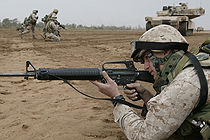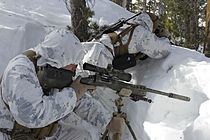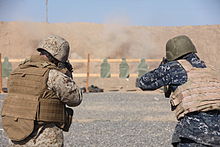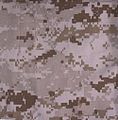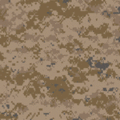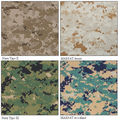- MARPAT
-
MARPAT (short for MARine PATtern) is a digital camouflage pattern in use with the United States Marine Corps, introduced with the Marine Corps Combat Utility Uniform (MCCUU), which replaced the Camouflage Utility Uniform. The pattern is formed by a number of small rectangular pixels of color. In theory, it is a far more effective camouflage than standard uniform patterns because it mimics the dappled textures and rough boundaries found in natural settings. This is caused by how the human eye interacts with pixelated images. It is also known as the "digital pattern" or "digi-cammies" because of its micropattern (pixels) rather than the old macropattern (big blobs).
The United States Marine Corps has patented MARPAT, including specifics of its manufacture.[1] By regulation, the pattern and items incorporating it, such as the MCCUU and ILBE backpack, are to be supplied by authorized manufacturers only and are not for general commercial sale, although imitations are available such as "Digital Woodland Camo" or "Digital Desert Camo".
MARPAT is also important in that it identifies warfighters as Marines to their enemies, while its camouflage simultaneously helps Marines to remain concealed. This was demonstrated by a Marine Spokesman who, when MARPAT was launched, said, "We want to be instantly recognized as a force to be reckoned with. We want them to see us coming a mile away in our new uniforms."[2]
Contents
Development
The concept of using miniature swatches of color as opposed to large splotches is not new; in World War II, German troops used various patterns similar to the current German Flecktarn, which involved similar small dabs of color on a uniform to provide camouflage.
The USMC design team in charge of this process went through over 150 different camo patterns before selecting three samples that met their initial objectives. These were two versions of Tiger stripes and an older design of British DPM that used colors from Rhodesia. The influence of the Tiger stripes can still be seen in the final MARPAT. These three samples were then reconstructed using new shapes and unique color blends that would allow a more effective uniform in a great range of environments.
The new patterns were then field tested in different environments, day and night, with night vision and various optics. MARPAT did exceptionally well in their wet uniform test when viewed with night vision while illuminated with IR, where normally patterns appear as a solid. The MARPAT patent lists U.S. Army research into fractal pattern camouflage as the basis for MARPAT.
The MARPAT pattern was chosen in a run-off against seven other patterns at the USMC Scout Sniper Instructor School.[3]
Field testing began in 2001, the uniform debuted in 2002, and the changeover was completed in October 2004.[4][5][6]
Design and colors
MARPAT has patterns produced by highly complex fractal equations that result in a non-repeating pattern. The purpose of the digitized pattern is to match the visual texture of typical backgrounds. When compared to a white background the MARPAT does look surprising and would seem to catch attention, but when used in an operative environment, its textured appearance and lack of hard edges make it more effective than traditional patterns.[3] While much was made of the unique design of the pattern when first adopted, it is in fact a recolored version of the Canadian CADPAT scheme with the Canadian Government assisting with its development.
There were initially three MARPAT patterns: Woodland, Desert, and Urban. Currently, only the Woodland and Desert patterns are used by the Marine Corps, replacing the U.S. Woodland pattern and the U.S. Three Color Desert pattern. Webbing and equipment worn with MARPAT Woodland and MARPAT Desert is produced in Coyote Brown, a mid-tone colour common to both the woodland and desert patterns. The Urban pattern was not approved for use. Although a digital snow pattern has also been adopted on cold weather training over-garments, this uses a different pattern from the Canadian company Hyperstealth. [7]
Authentic MARPAT material is distinguishable by an Eagle, Globe, and Anchor emblem incorporated into the pattern, in both the Woodland and Desert patterns.[8]
Similar designs
MARPAT is similar to Canadian Forces CADPAT, and is effectively a recoloured version of the Canadian pattern.[9]
The United States Army has incorporated its digital Universal Camouflage Pattern into the Army Combat Uniform (ACU). The ACU's pattern differs most notably because its color scheme is tan and gray and lacks the color black.
The United States Air Force has designed its own Airman Battle Uniform (ABU) using a standard Tiger Stripe pattern and slight variation on the color scheme of ACU.
The United States Navy announced approval for a digital "BDU-style" work uniform in late 2008. The Navy Working Uniform (NWU) was chosen by surveyed sailors for consistency and longer life, while the blue/grey/black Type I pattern was designed for aesthetic purposes rather than camouflage to disguise them at sea. In January 2010, the Navy began considering new Navy Working Uniform patterns modified from MARPAT, named Type II and Type III, desert and woodland respectively.[10] These patterns are overall darker than their respective MARPAT progenitors, modified with different color shades,[11] and addressed the fact that the blue and grey Type I pattern was not meant for a tactical environment (the Battle Dress Uniform and Desert Camouflage Uniform are still used for this purpose).[12] Backlash from Marines, including an objection from Commandant Conway, led to restrictions when NAVADMIN 374/09 was released:[13] Type II pattern to Naval Special Warfare personnel, while Type III is restricted to Navy ground units.[14]
Gallery of patterns
-
Infrared comparison of a Navy Working Uniform blouse to MARPAT trousers
-
An Iraqi Police officer wears a unique blue and grey variant
Users
 Air Marshal Fahad Al-Amir, the Chief of Staff of the Kuwaiti Armed Forces, speaks to Marines of the 26th Marine Expeditionary Unit wearing a unique MARPAT uniform
Air Marshal Fahad Al-Amir, the Chief of Staff of the Kuwaiti Armed Forces, speaks to Marines of the 26th Marine Expeditionary Unit wearing a unique MARPAT uniform
See also
- Battle Dress Uniform
- CADPAT
- List of camouflage patterns
- Marine Corps Combat Utility Uniform
- Tactical Assault Camouflage
- Universal Camouflage Pattern
References
- ^ US 6805957 "Camouflage U.S. Marine corps utility uniform: pattern, fabric, and design."
- ^ Blechman, Hardy; Newman, Alex (2004). DPM: Disruptive Pattern Material. Department of Publications, Maharishi. ISBN 0-9543404-0-X.
- ^ a b Combat Utility Uniform Camouflage Considerations
- ^ Saturday, February 24, 2001
- ^ Marine Corps Combat Utility Uniform
- ^ Maradmin - Mandatory Possession Dates For The Marine Corps Combat Utility
- ^ Snow Camouflage Uniform data sheet
- ^ Eagle, Globe and Anchor example, Magna Fabrics.
- ^ Jontz, Sandra (February 24, 2001). "Marines' followed Canadians' example in use of digitally-designed 'cammies'". Stars and Stripes. Archived from the original on December 27, 2007. http://web.archive.org/web/20071227060337/http://www.stripes.com/01/feb01/ed022401e.html. Retrieved 14 January 2010.
- ^ "Two New Navy Working Uniforms Announced". United States Navy. January 8, 2010. http://www.navy.mil/search/display.asp?story_id=50454. Retrieved 6 May 2010.
- ^ McCullough, Amy (January 20, 2010). "Your thoughts: Navy may try Corps-like camo". Marine Corps Times. http://www.marinecorpstimes.com/news/2010/01/marine_uniform_011810w/. Retrieved 6 May 2010.
- ^ "Navy Working Uniform (NWU) Concepts Frequently Asked Questions". Task Force Uniform Public Affairs. United States Navy. January 13, 2005. http://www.navy.mil/search/display.asp?story_id=16603. Retrieved 6 May 2010.
- ^ "NAVADMIN 374/09: Navy Working Uniform Type II and III". Chief of Naval Operations. CDR Salamander. January 4, 2010. http://cdrsalamander.blogspot.com/2010/01/nwu-unending-nightmare.html. Retrieved 6 May 2010.
- ^ "Sailor Outcry over Desert Camo Denial". Navy Times staff (Marine Corps Times). February 22, 2010.
- ^ Bill Center (25 January 2011). "New uniforms make Padres' military tribute harder to see". San Diego Union Tribune. http://www.signonsandiego.com/news/2011/jan/25/padres-new-camouflage-uniforms-make-militrary-trib/. Retrieved 17 February 2011.
External links
- Photos of USMC-issued MARPAT
- Notes from the original designer of MARPAT
- "Combat Utility Uniform Camouflage Considerations". United States Marine Corps. http://www.tecom.usmc.mil/mcub/utility/background/CammieConsid.htm.
- "Combat Utility Uniform - Conceptual Background". United States Marine Corps. http://www.tecom.usmc.mil/mcub/utility/background/UtesConcept.htm.
Categories:- American military uniforms
- Camouflage patterns
- Military camouflage
- United States Marine Corps equipment
Wikimedia Foundation. 2010.



